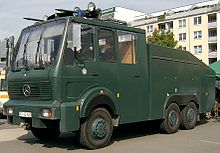Günter Sare
Günter Sare (born February 19, 1949 in Gelnhausen , † September 28, 1985 in Frankfurt am Main ) was a machinist and employee of a left youth center in Frankfurt-Bockenheim . He was run over by a water cannon during an anti-fascist demonstration and died of the injuries he suffered. His death sparked street battles between the autonomous community and the police.
Political activities
Günter Sare was a board member of the left youth center (JuZ) Bockenheim and has been active in the left-wing radical milieu since the beginning of the 1970s, which at that time repeatedly fought street fights with the police. Reasons for this were, among other things , the house-to-house war , especially in the Westend , with the first squatting in Germany, the resistance against nuclear power plants and NATO “retrofitting” or the construction of the West runway at Frankfurt Airport.
The evening of September 28, 1985
The 36-year-old Sare took part in a demonstration against a meeting of the NPD in Haus Gallus , the community center in the Frankfurt district of Gallus . As the site of the Frankfurt Auschwitz Trials (1963 ff.), Haus Gallus has a special historical significance in relation to National Socialism . The selection of this location for an event by the neo-Nazi NPD was - as intended - perceived as a provocation.
As a protest against the NPD, numerous left-wing groups organized a multicultural neighborhood festival in the courtyard of the neighboring Günderrode School, which was initially peaceful. Around 70 people took part in the NPD event, around 700 in the counter-demonstration. At around 7.30 pm, the first violent clashes between militant leftists and NPD supporters took place. After the NPD supporters entered the Gallus house under police protection, the police used water cannons against the counter-demonstrators. At the crossing Frankenallee / Hufnagelstraße around 9 p.m. one of these vehicles of the type WaWe 9 IV drove off towards a group of demonstrators. Günter Sare was the only one from this group who did not flee. He was hit by the jet of water, fell to the ground, and was then run over by the right rear wheel of the 27-ton vehicle. The rear axle crushed his chest. Sare suffered a fractured skull base on impact with the pavement . The then medical student Michael Wilk , a doctor and a paramedic provided first aid for around 20 minutes until an ambulance arrived. Günter Sare, however, was already dead. The first responders later made allegations that the police had obstructed them.
consequences
Fierce street battles broke out in Frankfurt and in many other cities in West Germany over the next few days. On the evening of Sare's death, which quickly became known, spontaneous riots caused property damage of 2 million marks. The then Lord Mayor Walter Wallmann finally imposed a temporary ban on demonstrations in Frankfurt in order to calm the situation.
The Hessian Greens , under the leadership of Joschka Fischer, were in negotiations with the SPD about the first red-green coalition in German history, interrupted these talks and demanded that the chief employer of the Hessian police, Interior Minister Horst Winterstein (SPD) Solving the events that led to Sare's death. The then Prime Minister Holger Börner had already been elected with the votes of the Greens last year and since then has led a minority government under “tolerance” of the Greens, which is now to be converted into a formal coalition. In December, Fischer finally became the first green state minister in Germany.
The criminal proceedings for the death of Sare ended in November 1990 in the second instance before the Frankfurt Regional Court , which acquitted the water cannon crew of the accusation of negligent homicide . According to the verdict, Sare had consumed alcohol and hashish before the accident and therefore misjudged the threat posed by the water cannon. The autopsy had shown a blood alcohol concentration of 1.49 ‰.
Günter Sare was buried in the Höchst cemetery.
Web links
- Stephan Loichinger: Günter Sare's death has not yet been clarified Frankfurter Rundschau, September 18, 2003
- Wolfgang Stenke: 20 years ago the protester Günter Sare was run over by the police Deutschlandfunk, September 28, 2005
- Antifa Frankfurt: Documents on the death of Günter Sare and the reactions , 2005 ff.
Individual evidence
- ^ A b Frankfurter Rundschau: Günter Sare's death is still unclear today. September 18, 2003, accessed October 23, 2018 .
- ↑ On the death of Günter Sare. Retrieved October 23, 2018 .
| personal data | |
|---|---|
| SURNAME | Sare, Günter |
| BRIEF DESCRIPTION | German machinist |
| DATE OF BIRTH | February 19, 1949 |
| PLACE OF BIRTH | Gelnhausen |
| DATE OF DEATH | September 28, 1985 |
| Place of death | Frankfurt am Main |


